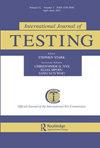Detecting Curvilinear Relationships: A Comparison of Scoring Approaches Based on Different Item Response Models
IF 1.4
Q2 SOCIAL SCIENCES, INTERDISCIPLINARY
引用次数: 6
Abstract
There is a growing use of noncognitive assessments around the world, and recent research has posited an ideal point response process underlying such measures. A critical issue is whether the typical use of dominance approaches (e.g., average scores, factor analysis, and the Samejima's graded response model) in scoring such measures is adequate. This study examined the performance of an ideal point scoring approach (e.g., the generalized graded unfolding model) as compared to the typical dominance scoring approaches in detecting curvilinear relationships between scored trait and external variable. Simulation results showed that when data followed the ideal point model, the ideal point approach generally exhibited more power and provided more accurate estimates of curvilinear effects than the dominance approaches. No substantial difference was found between ideal point and dominance scoring approaches in terms of Type I error rate and bias across different sample sizes and scale lengths, although skewness in the distribution of trait and external variable can potentially reduce statistical power. For dominance data, the ideal point scoring approach exhibited convergence problems in most conditions and failed to perform as well as the dominance scoring approaches. Practical implications for scoring responses to Likert-type surveys to examine curvilinear effects are discussed.检测曲线关系:基于不同项目反应模型的评分方法比较
非认知评估在世界各地的使用越来越多,最近的研究已经提出了一个理想的点反应过程作为这些措施的基础。一个关键问题是,在对这些指标进行评分时,通常使用优势方法(例如,平均得分、因素分析和Samejima分级反应模型)是否足够。本研究检验了理想得分方法(例如,广义分级展开模型)与典型优势得分方法在检测得分特征和外部变量之间的曲线关系方面的性能。仿真结果表明,当数据遵循理想点模型时,理想点方法通常比优势方法表现出更大的威力,并提供更准确的曲线效应估计。在不同样本量和量表长度的情况下,理想点和优势评分方法在I型错误率和偏差方面没有发现实质性差异,尽管特征和外部变量分布的偏倚可能会降低统计能力。对于优势数据,理想点评分方法在大多数情况下都存在收敛问题,并且表现不如优势评分方法。讨论了对Likert型调查进行评分以检验曲线效应的实际意义。
本文章由计算机程序翻译,如有差异,请以英文原文为准。
求助全文
约1分钟内获得全文
求助全文
来源期刊

International Journal of Testing
SOCIAL SCIENCES, INTERDISCIPLINARY-
CiteScore
3.60
自引率
11.80%
发文量
13
 求助内容:
求助内容: 应助结果提醒方式:
应助结果提醒方式:


